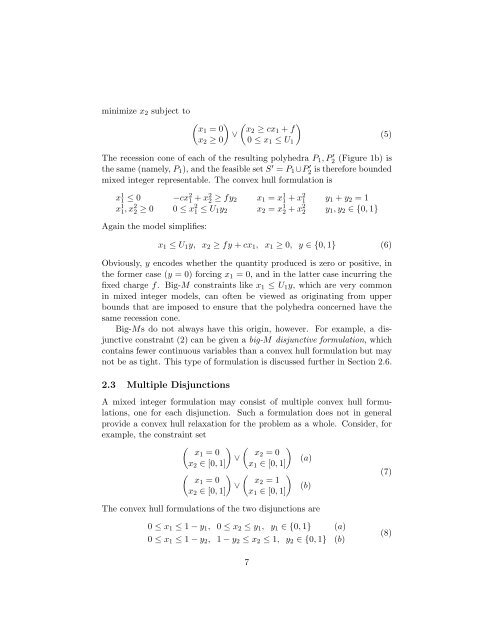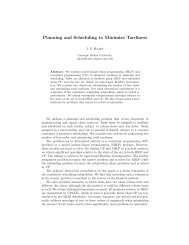A Principled Approach to Mixed Integer/Linear Problem Formulation
A Principled Approach to Mixed Integer/Linear Problem Formulation
A Principled Approach to Mixed Integer/Linear Problem Formulation
Create successful ePaper yourself
Turn your PDF publications into a flip-book with our unique Google optimized e-Paper software.
minimize x 2 subject <strong>to</strong>( ) ( )x1 =0 x2 ≥ cx∨1 + fx 2 ≥ 0 0 ≤ x 1 ≤ U 1(5)The recession cone of each of the resulting polyhedra P 1 ,P 2 ′ (Figure 1b) isthe same (namely, P 1 ), and the feasible set S ′ = P 1 ∪P 2 ′ is therefore boundedmixed integer representable. The convex hull formulation isx 1 1 ≤ 0 −cx 2 1 + x2 2 ≥ fy 2 x 1 = x 1 1 + x2 1x 1 1 ,x2 2 ≥ 0 0 ≤ x 2 1 ≤ U 1y 2 x 2 = x 1 2 + x2 2y 1 + y 2 =1y 1 ,y 2 ∈{0, 1}Again the model simplifies:x 1 ≤ U 1 y, x 2 ≥ fy + cx 1 , x 1 ≥ 0, y ∈{0, 1} (6)Obviously, y encodes whether the quantity produced is zero or positive, inthe former case (y = 0) forcing x 1 = 0, and in the latter case incurring thefixed charge f. Big-M constraints like x 1 ≤ U 1 y, which are very commonin mixed integer models, can often be viewed as originating from upperbounds that are imposed <strong>to</strong> ensure that the polyhedra concerned have thesame recession cone.Big-Ms do not always have this origin, however. For example, a disjunctiveconstraint (2) can be given a big-M disjunctive formulation, whichcontains fewer continuous variables than a convex hull formulation but maynot be as tight. This type of formulation is discussed further in Section 2.6.2.3 Multiple DisjunctionsA mixed integer formulation may consist of multiple convex hull formulations,one for each disjunction. Such a formulation does not in generalprovide a convex hull relaxation for the problem as a whole. Consider, forexample, the constraint set(x1 =0x 2 ∈ [0, 1](x1 =0x 2 ∈ [0, 1]))( )x2 =0∨x 1 ∈ [0, 1]( )x2 =1∨x 1 ∈ [0, 1](a)The convex hull formulations of the two disjunctions are(b)(7)0 ≤ x 1 ≤ 1 − y 1 , 0 ≤ x 2 ≤ y 1 , y 1 ∈{0, 1} (a)0 ≤ x 1 ≤ 1 − y 2 , 1 − y 2 ≤ x 2 ≤ 1, y 2 ∈{0, 1} (b)(8)7




